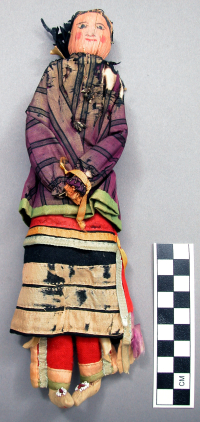cornhusk doll
cornhusk doll
cornhusk doll



This cornhusk doll of a female was made by Mrs. Baird and completed with a full outfit. Her clothes are made from fabric, including black and red common stroud, and a purple silk blouse with black stripes of the "short gown" type. There are snaps on the blouse. The skirt is decorated with two narrow ribbons of different sizes. Size 10 seed beads in clear maroon or burgundy and black, as well as size 12 seed beads in clear red and opaque white. The mocassins are made of hide. GRASAC researchers thought the doll's hair is made from black silk, however, museum records suggest horsehair. The doll is sewn with cotton thread. The features on the face have been painted on.
This relative currently resides at the Peabody Museum of Archaeology and Ethnology.
Menomini
Museum documentation
Museum documentation and GRASAC researcher visit.
Read More About This Relative
Fabric, Corn husk, Ribbon, Glass, Hide, Metal, Horsehair or black silk, Pigment.
The artist soaked the cornhusk in warm water. The cornhusk is tied together with cotton thread. Once the doll's head is formed, the artist painted on the nose, eyes, and mouth with pigment. The horsehair or silk is placed on the doll's head. Also, the doll's ribbon shirt, skirt and leggings are sewed separately. Lastly, glass beads are sewn onto the cornhusk's moccasin vamps.
The motifs on the moccasin vamps consist of a floral design.
A child's toy.
Museum documentation
Provenance
Miss Fairchild donated the cornhusk doll to the President and Fellows of Harvard College.
Museum documentation
About This GRASAC Record
Mrs. Baird. Cornhusk doll. GKS ID 58949. Peabody Museum of Archaeology and Ethnology catalogue number 16-18-10/86696.
Two records for this doll were identified on May 31, 2024 (GKS ID 26581 and GKS ID 58949). Cara Krmpotich combined the information into the record for GKS ID 58949.
Cory Willmott, Alan Corbiere, Adrianna Grecci Green and David Penney conducted research on site at the Peabody Museum for Archaeology and Ethnology in July 2007 with help from Susan Haskell and Patricia Capone of the PMAE. Cory Willmott's research was funded by a grant from the American Philosophical Society. Al Corbiere was supported through Ruth Phillips's SSHRC Canada Research Chair Funding. An internal grant from Southern Illinois University Edwardsville provided Cory with an RA, Ceara Horsley, for 2009 and 2010 to work on GRASAC data entry.
 Knowledge Sharing Platform
Knowledge Sharing Platform


